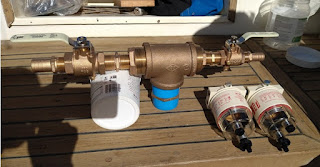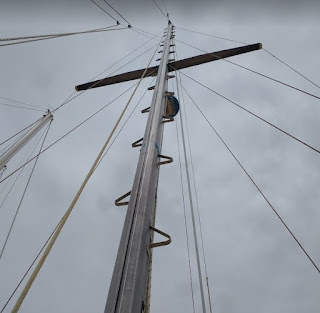We sure love cruising in Mexico. There is nothing better. Reluctantly, we've decided that it is just not feasible for us to do this right now or in the near future. Those of you who know us know why. Those who don't, well... let's just say that it is a healthcare situation that keeps us close to Olympia Washington for the time being. And so, we are selling our dear Nepenthe.
If you have read previous posts in this blog you know about all the work we've put into her these last three years. We've gone through all the systems and replaced and repaired just about everything that needed, shall we say, "deferred maintenance."
In 2023 we cruised her in the Sea of Cortez and then in 2024 we did the same, getting as far south as LaPaz. She was last in the water in May 2024.
We still have our Passport 42, Traveler, here in sunny Olympia and will continue to explore the Salish Sea with her. Our charter business continues, Mystic Journeys on Traveler, is going strong.
We keep her in San Carlos, on the hard, at Marina Seca San Carlos. San Carlos is far enough north that the hurricanes have a hard time making trouble this far from their breeding ground. The boat is kept in the storage area, along with a few hundred other boats, then when you want to work on the boat, it gets moved to a work yard where their is power, water and access to services. Normally we put her in the work yard, do our planned work, then splash her into the bay. The marina there is reasonably priced and we usually spend a few days at the dock then take off into the Sea of Cortez. We used San Carlos for SV Traveler some years back and now do the same with Nepenthe.
We can show the boat while it's in the storage yard. When someone is interested, we then move her into the work yard, then into the water for a sea trial.
And now I'm going to list some specs,
show you many of the improvements and replacements we've done, and show some pictures of Nepenthe .
The specifics:
Nepenthe 1986 Pan Oceanic 38 A flush deck, pilot house, cutter, designed by Ted Brewer. Built in the Philippines, Nepenthe was bought there by the original owner and sailed to Turkey where teak decks were installed (glued on). Then he sailed to California and finally to the Sea of Cortez.
Ted Brewer’s Pan Oceanic line of sailboats started with a 46 footer (40 or 50 of them) , then a 43 footer (about 15), then he was asked to squeeze all the features of the larger boats into a 38 footer. Only six 38’s have been identified.
USCG # 934244 HIN # FSL3801A686
Lwl 37.8 Width 11.9 Depth 5.5 Displacement 18,750.00 lb Ballast 7,000 lb
6;3" headroom throughout - Master berth is 6'6" long - A good boat for tall people.
Mexico TIP new dated 4 June 2024
The following list is all NEW in the last 2 years: $34k spent
Rebuilt Isuzu 50 HP 4LE diesel engine 2024 (that was a big expense!)
Serviced alternator
Serviced heat exchanger
Serviced starter
New engine harness
Balanced propeller
Cutlass bearing
Re-packed stuffing boxes
Prop shaft and coupler / drive saver
Exhaust hose
Water pump – Jabsco 1673-1001
Fuel Pump, fuel switching system, fuel filters
Maxwell VW1000 Windlass, foot switches, fused breaker Maxwell SP5104 Reversing Solenoid
Anchor chain – 230 ft. 3/8 inch
Tank Tender for 4 tanks
CPT AutoPilot – wheel mount
Magma Stainless Steel, rail mounted grill
SS Bimini framework for solar panels and dinghy motor hoist
2 Solar panels AIMS Power 120 watt each - 240 watt total
Aims 30 amp solar charge controller and Renogy Wanderer 10 Amp
Shore power charger BatteryLink Multi-Stage Charger with ACR - 20 Amps
4 – Full River 115 Ah Group 31 house batteries AGM 460 Ah total 2024
1 – Full River 100 Ah Group 27 starter battery AGM 2024
Foot pump for fresh water at galley sink
Replaced all SS hose clamps
Lots of new wiring, all new battery/starter cables
3 cabin fans
Comfy marine foam on queen master mattress and Vee berth
Marine head, hoses and plumbing
GPS -Garmin ECHOMAP UHD2 54cv 5” chart plotter
7 new bronze thru-hulls, seacocks, valves, and hoses (another big expense)
Bottom paint
Hatch and port light rubber gaskets
Replace most interior light fixtures and all LED bulbs
On demand fresh water pump
Bilge pump
Rebuilt rudder, and new bearing
Replaced four lower shrouds and turnbuckles
Anchor light
Windex
Fire extinguishers
Oil and fuel filters
Depth sounder
Inverter
Freezer - Isotherm Compact Classic 2301
Refrigerator - Isotherm 2050 SP Water Cooled Refrigeration,
Groco IBV-1250 Full Flow Inline Ball Valve –
New, in-box electrical panel
Other items that came with the boat in 2021:
60 Lb CQR Anchor
40 Lb Bruce Anchor
20” Aluminum Danforth Anchor mounted on stern rail
VHF
3 burner gimbaled propane stove with oven
2 propane tanks in vented cockpit storage
Aries wind vane steering system
Mainsail
Genoa
Staysail
Gennaker with sock
Storm Jib
Mast steps
SSB – not connected
Tools and spare parts
Pots, pans, dishes, cutlery
PFDs
Fishing poles
Separate solar panel for starter battery
Running and standing rigging
Fenders and mooring lines
Anchor rode snubber / bridle
Miscellaneous line
Set of 6 flopper stoppers
Some Pictures...

 |
| Some of the new bronze fittings and fuel filters |
 |
| Thick hull, yes? |

 |
| The new CPT autopilot works really well. |
 |
| Sturdy covers for the pilot house windows. We put these on for summer storage. |
 |
| Mast steps make it easier to get up there. |
 |
| Lots of freeboard |
 |
| Sweet front deck, room for dinghies and yoga. |
 |
| Colorful geniker |
If you are interested, call or text 206-747-1985
or email swvoltz@gmail.com
Here are some interior pictures:
 |
| Storage under Vee with staysail, storm jib, and trysail |
 |
| Double Bed 6'6" long and 56 " wide |











































